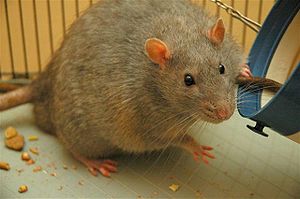Portal:Mammals/Intro

Mammals (class Mammalia) are vertebrate animals characterized by the presence of sweat glands, including milk producing sweat glands, and by the presence of: hair, three middle ear bones used in hearing, and a neocortex region in the brain. Mammals, other than the monotremes, give birth to live young instead of laying eggs. They also possess specialized teeth and use a placenta in the ontogeny. The mammalian brain regulates endothermic and circulatory systems, including a four-chambered heart. Mammals encompass approximately 5,400 species, ranging in size from the Bumblebee Bat, (30-40mm), to the Blue Whale, (33,000mm), distributed in about 1,200 genera, 153 families, and 29 orders, though this varies by classification scheme.
Most mammals belong to the placental group. The four largest orders within the placental mammals are Rodentia (mice, rats, and other small, gnawing mammals), Chiroptera (bats), Carnivora (dogs, cats, bears, and other mammals that primarily eat meat), and Cetartiodactyla (including numerous herbivore species, such as deer, sheep, goats, and buffalos, plus whales).
Phylogenetically, Mammalia is defined as all descendants of the most recent common ancestor of monotremes (e.g., echidnas and platypuses) and therian mammals (marsupials and placentals). This means that some extinct groups of "mammals" are not members of the crown group Mammalia, even though most of them have all the characteristics that traditionally would have classified them as mammals. These "mammals" are now usually placed in the unranked clade Mammaliaformes.
The mammalian line of descent diverged from the sauropsid line at the end of the Carboniferous period. The sauropsids would evolve into modern-day reptiles and birds, while the synapsid branch led to mammals. The first true mammals appeared in the Jurassic period. Modern mammalian orders appeared in the Palaeocene and Eocene epochs of the Palaeogene period.
